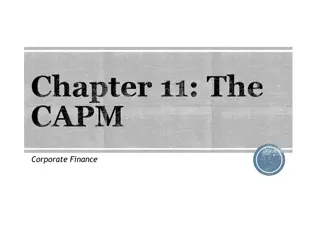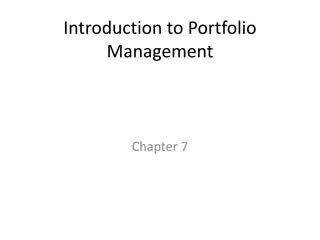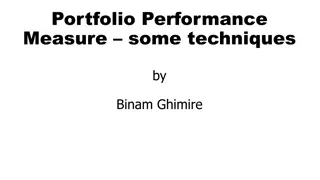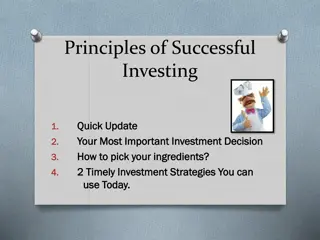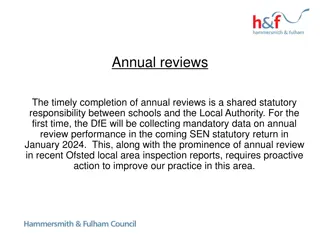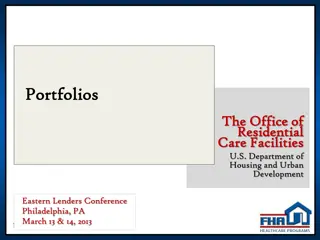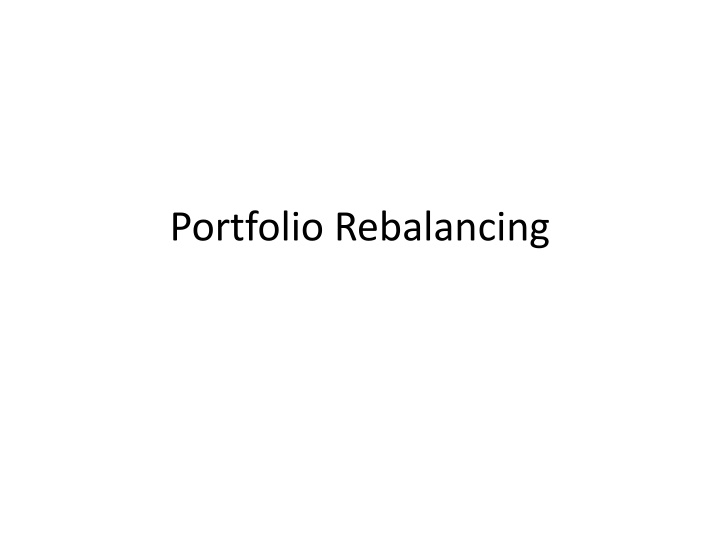
Effective Portfolio Rebalancing Strategies for Success
"Learn about the importance of portfolio rebalancing to meet financial objectives, the risks involved, costs to consider, common pitfalls to avoid, and the impact of cultural differences on investment decisions. Discover key insights to successfully manage and adjust your portfolio in dynamic market conditions."
Uploaded on | 1 Views
Download Presentation

Please find below an Image/Link to download the presentation.
The content on the website is provided AS IS for your information and personal use only. It may not be sold, licensed, or shared on other websites without obtaining consent from the author. If you encounter any issues during the download, it is possible that the publisher has removed the file from their server.
You are allowed to download the files provided on this website for personal or commercial use, subject to the condition that they are used lawfully. All files are the property of their respective owners.
The content on the website is provided AS IS for your information and personal use only. It may not be sold, licensed, or shared on other websites without obtaining consent from the author.
E N D
Presentation Transcript
Portfolio rebalancing Rebalance the portfolio to Meet objectives laid down even in Changed conditions
Portfolio rebalancing Risk-return trade-off Cost of revising the portfolio: Commissions and brokerages Bid-ask spread Non-financial cost: Investment manager may lose his credibility
Portfolio rebalancing Costs of trading away from rebalancing (buy and hold strategy): 1. Holding a portfolio or an asset that is overpriced and hence inferior returns. 2. Composition of a portfolio may no longer reflect the investor s objectives 3. A poorly diversified portfolio, which is riskier than what an investor can bear
Pitfalls to be avoided in portfolio rebalancing 1. Projecting the past into future without analysis 2. Cultural differences
Project the past into future without analysis Tendency to believe that anything that worked well in the past will continue to do so
Cultural differences Behavior and attitudes of successful investors are often remarkably different from what can be expected from a profit-seeking organization. Commercial entities reward success and punish failure
Cultural differences Successful investors do not hesitate to stay with the laggard till the profit potential is realized They do not sell securities because the returns are poor in one period, if the promise for the future is bright
Cultural differences Another folly is going with the crowd Fund managers may find it easy to go with the market and lose money rather than go against it and lose money
Need for rebalancing Many reasons why portfolio of a client may have to be changed
Change in wealth According to utility theory, risk taking ability increases with increase in wealth People can afford to take more risk as they grow rich and benefit from its rewards But, in practice, may not be true As people get rich, they become more concerned about losing the newly got riches than getting richer
Change in wealth Fund manager should observe the changes in the attitude of the investors toward risk and try to understand them in a proper perspective If investor turns to be more conservative after huge gains
Change in time horizon Some events take place that may modify the time horizon Births, deaths, marriages and divorces impact investment horizon
Changes in liquidity needs Investors may ask the portfolio manager to keep enough scope in portfolio to get some cash as and when they want Liquidity requirement reduces investible funds in fixed income and/or growth securities Reduces money available to achieve investor s goal on return
Changes in taxes Rate of tax under long-term capital gains is usually lower than the rate applicable for income Change in minimum holding period for long- term capital gains or rates
Bull and bear markets Fluctuations in stock markets provide opportunities for both positive and negative aspects Periods where stock return is more than bond return and vice versa. Applies to individual securities also
Central bank policy Central bank and other banks enjoy a greater power in influencing liquidity in capital markets Monetary and liquidity constraints influence stock markets Monetary policy also has immediate effect on money markets, though less effect on long- term bond yields.
Inflation rate changes According to Fama, unexpected changes in the rate of inflation has effects in pricing of stocks in either direction When inflation increases beyond expectations, bond investors face a reduced real yield on the bonds. Nominal yield then rises so as to counteract the loss, bond prices fall.
Inflation rate changes Significant impact on stock market returns as well. More than consumer price index, changes in producer prices provide better signals for future returns.
Changing return prospects Other things being equal, changes in prices accompany changes in return prospects With each negative fluctuations in the bond s price, its yield rises but its total return falls These changes eventually lead to the adjustments in the investor s portfolio
Transaction cost barrier Can never be recovered and cumulative erosion value can at times be harmful Consist of more than just commissions Actual cost of transacting is the difference between the realized price and the price that must have existed in the absence of the order There can be trades that one seeks to carry out, but fails to execute, which provides another tariff, an opportunity cost
Drifting mix Clients and investment managers strive hard, so that asset policy reflects an aversion towards risk as well as reflect a good return prospect
Drifting mix Two sensible views on asset allocation exists. 1. Active shift should add value 2. Market efficiency which assumes to preclude profitable switching among asset classes
Portfolio Revision Portfolio management, maximum emphasis on portfolio analysis and selection Optimal portfolio Portfolio revision is equally important
Need Markets continually change Conditions change what is optimal Revision to ensure optimality
Need 1. Availability of additional funds for investment 2. Change in risk tolerance 3. Change in the investment goals
Need 4. Need to liquidate a part of the portfolio to provide funds for some alternative use Need from changes in the financial market or changes in the investor s position namely his financial status and preference
Portfolio Portfolio is a mix of securities Two variables: 1. Securities included in the portfolio 2. Proportion of total funds invested in each security
Portfolio Revision Involves Either changing the securities currently included in the portfolio Or altering the proportion of funds in the securities
Objective Same as portfolio selection Maximising the return for a given level of risk Or Minimizing the risk for a given level of return
Constraints in Portfolio Revision Adjusting the existing portfolio in accordance with the changes in the financial markets and the investor s position Involves purchase and sale of securities
Constraints in Portfolio Revision Transaction cost Taxes on capital gains Intrinsic difficulty no clear methodology
Active Revision Frequent and substantial Objective: Beat the market Believe markets are not continuously efficient Securities mispricing at times gives an opportunity for beating market
Active Revision Believe that different investors have divergent or heterogeneous expectations on markets Practitioners of active revision are confident of developing better estimates of the true risk and return of securities than rest of the market
Active Revision Combines both fundamental and technical analysis Demand on time, skills and resources high Higher transaction cost
Passive Revision Minor and infrequent Believes in market efficiency and homogeneity of expectations among investors According to predetermined goals Formula plans normally
Formula Plans Prices of securities fluctuate Buy low and sell high
Formula Plans Investors may not profit from price fluctuation But investors hesitate, prices may fall further or prices may not move upwards again Similarly, when prices rise, do not sell, thinking it may rise further
Formula Plans Represent an attempt to exploit the price fluctuations in the market and make them a source of profit Make decision on timing of buying and selling automatic and eliminate the emotions
Formula Plans Predetermined rules on when to buy or sell How much to buy and sell Calls for action with changes in securities market
Formula Plans Demands the division of investor s funds into: Aggressive portfolio - shares Conservative or defensive portfolio - bonds
Formula Plans - Types Constant dollar value plan Constant ratio plan Dollar cost averaging
Constant Dollar Value Plan When share prices fluctuate, value of aggressive portfolio changes When prices increase, total value of aggressive portfolio increases Sell some of the shares in the aggressive portfolio to the level of the original investment and invest it in bonds
Constant Dollar Value Plan When share prices fall, total value of the aggressive portfolio falls To keep the total value of aggressive portfolio, funds are transferred from bonds to shares
Constant Dollar Value Plan Effectively, investor buys when prices are low, sells when prices are high Action points to be carefully determined in advance Like 10%, 15% or 20%
Constant Ratio Plan Variation of constant dollar value plan Ratio between aggressive portfolio and defensive portfolio predetermined like 1:1 or 1.5:1, etc Purpose is to keep the ratio constant
Constant Ratio Plan Revision point is also predetermined like +/- 10%
Dollar Cost Averaging Stock prices fluctuate up and down in cycles Dollar cost averaging utilises this cyclic movement to construct a portfolio at low cost






